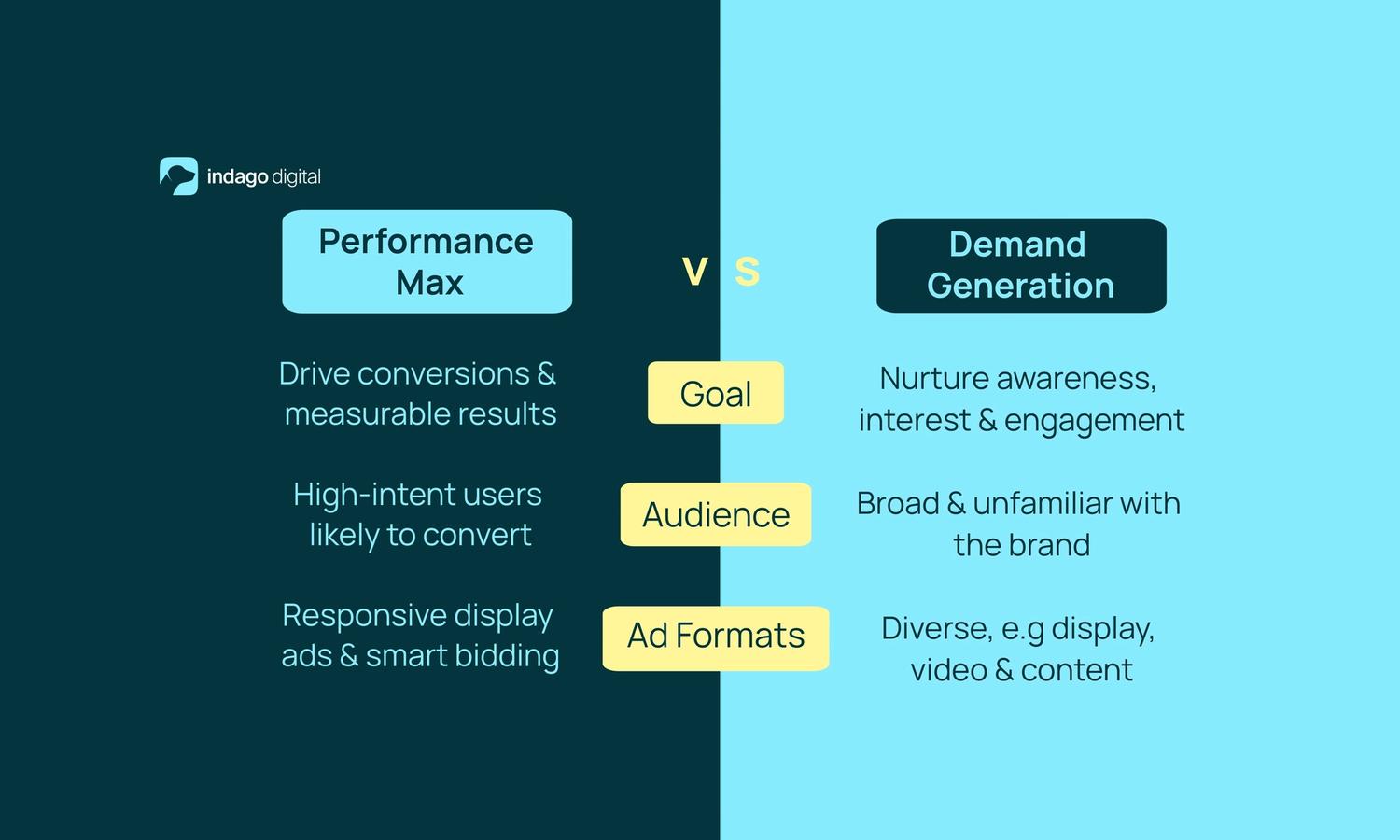What is Demand Gen & how does it work?
Demand Generation (Demand Gen) campaigns are an evolution of traditional Google Discovery Ads, adding placements like YouTube Shorts, YouTube in-feed, Discover, and Gmail to the mix.
The goal of these new Demand Gen placements is to boost brand awareness and drive lead generation. For example, by engaging potential customers while they’re in research mode (and before they've made other brand commitments!), businesses can leverage these placements and nudge them toward conversion.
Learn more about The 9 Google Ads Types & Which Is Best for Your Campaign.

Why Demand Generation marketing matters for B2B
Demand Generation marketing represents a new era in B2B advertising. Its combination of placements, improved audience control, and smarter bidding strategies gives businesses an edge in reaching the right people at the right time.
It’s like social campaigns, but with Google’s reach and data muscle behind it, offering businesses easier targeting options, especially when reaching other businesses. A standout feature is its support for lookalike audiences, enabling targeting of audiences similar to your existing converters.
- Broader reach, better results: Tap into a massive pool of up to 3 billion active users across various platforms. It’s like running a social media campaign but with Google Ads performance to back it up.
- Beyond just leads: Sure, Demand Gen can score you leads, but it’s not just a numbers game. A well-oiled campaign keeps your audience hooked on your brand and coming back for more.
- Control your audience, control your outcome: Unlike Performance Max (Pmax), you’re in the driver’s seat. Choose who sees your ads and when, making sure your message lands with the right crowd.

What is Demand Generation vs Lead Generation?
It's crucial for businesses to understand that the goal of Demand Gen campaigns is to create awareness, interest, and engagement for their brand, product, or service.
While lead generation focuses on collecting leads for immediate sales, demand generation aims to build long-term relationships by nurturing prospects and creating demand among audiences who may not be aware of or actively searching for your offerings.
This distinction is key to building a robust funnel that drives interest and engagement across platforms.
Your checklist for optimised Google Demand Gen campaigns
Ready to learn how to optimise your Demand Gen campaigns in Google Ads? Here are our top 7 tactics for that slam-dunk result.
1. Align campaign goals with business objectives
Demand Gen supports a range of campaign goals—traffic, sales, leads, brand awareness, consideration, app promotion, and local store visits so nail down your goals first.
Think of it as setting the GPS for your campaign’s success. The clearer your destination, the better Google’s algorithm can steer you there.
- Top of the Funnel (Awareness & Consideration): Perfect for new product launches or boosting brand visibility.
- Middle Funnel (Website Traffic): Drive curious users to dive deeper into what you offer.
- Bottom of the Funnel (Leads, Sales, App Promotion, Local Visits): Turn interest into action, from sales to store visits.
2. Choose the right tools: Demand Gen vs Performance Max
Performance Max (Pmax) and Demand Generation (Demand Gen) campaigns both offer broad placements, but they serve different masters.

Pmax covers everything Demand Gen does but leaves the details to Google’s AI, which can be a double-edged sword if you like to call the shots.
- Pmax: Ideal for businesses seeking broad audience reach, relying on Google's inventory for distribution. However, it offers minimal control over targeting and setup, leveraging advertiser-provided audience signals to identify potential actions beneficial to the business. Pmax is typically used for conversion or value-based optimizations.
- Demand Gen: The perfect tool for businesses that want to handpick their audience and bidding strategies across Google’s inventory like Gmail, Discover, and YouTube. This flexibility allows optimisation for various objectives, including traffic, conversions, and sales.
The right choice? It depends on your business needs and how much control you want over the reins.
4. Balance human creativity & AI assets
Google provides AI-generated assets that are customised for each business. While these images aren’t always campaign-ready, advertisers can use them as a springboard to craft eye-catching visuals that align with your brand.
Check out our recent blog on The Pitfalls of AI Art: Testing PMAX's AI Assets.
Plus, as the tool continues to evolve, it promises substantial time savings in asset creation and could significantly reduce the turnaround time for campaigns to launch.
Remember, variety is key. Think of your creatives as a multi-course meal—different sizes, formats, and styles to satisfy every appetite.
5. Budget using insights from your social campaigns
Demand Generation campaigns often yield results in terms of reach, traffic, and conversions that are comparable to social media marketing campaigns on platforms like TikTok and Meta. This parity is partly thanks to the inclusion of YouTube inventory, particularly through formats like Shorts.
When determining a budget for Demand Generation, advertisers and businesses can leverage insights from their social media campaigns to make an informed decision that aligns with their overall marketing strategy and goals. Essentially, if it works there, it’ll work here too.
6. Segment smarter with audience targeting
Precision is power. Start with the audiences you know best, then level up with lookalike audiences to mirror your top converters.
Use these tactics to make your audience targeting work smarter:
- Craft Relevant Creatives: Match your ad creatives to your audience's tastes and use competitor research to ensure your ads stand out, especially in formats like YouTube Shorts—short, snappy, and impossible to ignore.
- Tap into Google's Affinity/Interest Audiences: Create Lookalike audiences that mirror your best customers.
- Diversify Your Assets: Mix it up with a variety of assets and ratios. This strategy helps Google's algorithms serve up the right creative to the right audience.
- Cut the Fat: Exclude your already converted audiences from all ad groups to maximise your budget.
- Remember to Remarketing: Retarget with remarketing to reel in those who showed interest but didn’t convert.
7. Check everything before you go live
Before hitting the launch button, triple-check all the essentials. Scrutinise start and end dates, final URLs, locations, languages, and budgets. A little diligence goes a long way.
Getting started with Demand Gen? Don’t wing it. Seek guidance from Google experts or digital agencies that know their stuff. A second set of eyes can spot what you might miss.
Conclusion
Ready to elevate your Demand Gen campaigns in Google Ads? With these strategies, you'll not only boost your brand's visibility but also drive more qualified leads without breaking the bank. Don't settle for mediocre results when you can optimise for success.
Need help optimising your paid marketing strategy?
Book a chat with Luke, our Head of Paid Media and let’s transform your Google Ads strategy into a powerhouse of conversions!
Written by
Brooke Eager





